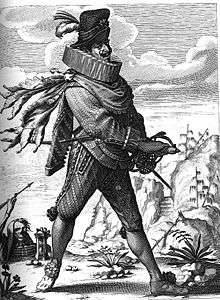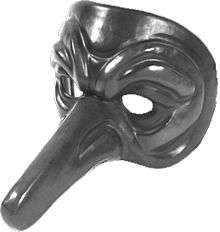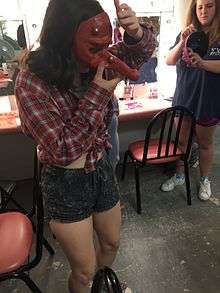Il Capitano
Il Capitano ([il kapiˈtaːno], Italian for "The Captain") is one of the four stock characters of Commedia dell'arte.[1] He most likely was never a "Captain" but rather appropriated the name for himself.[2]

He is often a braggart and a swaggerer[3] who can maintain his claims only by benefit of the fact that none of the locals know him. He is usually a Spaniard,[4] given the fact that for most of the late Renaissance to well into 17th century, parts of Italy were under Spanish domination. He was most likely inspired by the boisterous Iberic caudillos who told tall tales of their exploits either in the conquest of the Americas or in the wars with Germany.
Il Capitano often talks at length about made up conquests of both the militaristic and carnal nature in attempts to impress others, but often only ends up impressing himself. He gets easily carried away in his tales and doesn't realise when those around him don't buy his act. He would be the first to run away from any and all battles, and he has trouble talking to and being around men. He is also extremely opportunistic and greedy. If hired by Pantalone to protect his daughter from her many suitors, Capitano would set up a bidding war for his services or aid between the suitors and Pantalone while wooing her himself. If he is hired to fight the Turks, he will bluster about fighting them to his last drop of blood, but when the Turks seem to be winning, he will join them. When they are driven off, he will change sides again and boast about his loyalty and bravery.
Role
"I think of him as a peacock who has moulted all but one of his tail feathers, but does not know it," notes author John Rudlin.[2] In this case, his cowardice is usually overcome by the fury of his passion, which he makes every effort to demonstrate. Typically, however, his cowardice is such that when one of the characters orders him to do something, he often steps down out of fear, but is able to make up an excuse that ensures the other characters still see him as a brave and fierce individual. Columbina sometimes uses him to make Arlecchino jealous, much to Capitano's bewilderment and fright.
Origin
The origin of Capitano comes from 2 sources literary sources: Plautus's Miles Gloriosus and Terence's Eunuchus.[3] The first famous Captain, Capitano Spavento, appeared in Francesco Andreini's Bravure di Capitan Spaventa (The Boast of the Terrifying Captain). [5][6][7]
Lazzi
- Whenever Capitano sees the audience, he stops to be admired.[2]
- Capitano gloats to Arlecchino (Harlequin) about his expertise with the ladies and then proceeds to demonstrate on Arlecchino how he would make love to a woman.[2]
- He wakes up to find he is not the only one in the room. There is someone crouching in the corner. He shakes his fist at the person, the person shakes their fist back at the same time. It turns out the person in the room is just Capitano's reflection in a full length mirror.[4]
- When frightened, he often screams in a high and womanly falsetto, or else faints.
Stance
He stands in a high posture, occupying as much space as possible, with a straight back and his chest pushed forward.[8]
Plot Function
To be exposed or 'de-masked'. He exists to be stripped of his excessive confidence and shown in a moment of panic and humility.[2]
Description of the character

Mask

His mask is described as having "a long nose, often unambiguously phallic"[8] The nose for Captain Spavento's mask is fairly large, but it lengthens with Matamoros, and becomes absolutely gargantuan for Coccodrillo. Originally, the color of the mask was probably flesh tone, now it can be many flamboyant colors such as bright pink, yellow, and light blue.[4][8]
UNmasked Capitano: II Cavaliere (The Lover Capitano).[2]
Costume
Military-esque uniform (a satire on the period). 1500s: feathered helmet or hat (mom panache), exaggerated garters, extraordinarily long sword and a plethora of ruffles. 1600s: coat, breeches, and he would mostly have a musket instead of a sword.[9][4] In one famous scenario, the Captain makes up a lie regarding the reason for his lack of an undershirt by claiming that it got that way because "I used to be an exceedingly fierce and violent man, and when I was made angry the hair which covers my body in goodly quantity stood on end and so riddled my shirt with holes that you would have taken it for a sieve." The real reason is that he has been too poor to afford one. Sometimes he wears it with a helmet or a bicorne or tricorne hat with a huge plume. Spanish characters often wear an exaggerated large neck-ruff.
He is usually always wearing his trademarked sword. If he were to ever work up enough nerve to draw it, it is usually too long to draw easily or too heavy or wobbly to wield properly. Even if he cut somebody with it, he would faint at the very sight of the blood.
Noms de guerre
Il Capitano usually has a properly showy name for himself, preferably several lines long and followed by many made-up titles and lists of relations.
Some names are fierce-sounding, like "Escobombardon" ("Fired out of a cannon"), "Rodomonte" ("Mountain-crumbler"), "Sangre y Fuego" (Spanish: "Blood and Fire"), "Spaccamonti" ("Mountain splitter"), "Spezzaferro" ("Iron-breaker"), or "Terremoto" ("Earthquake"). Some names are ironic, like: "Bellavista" ("Beautiful view", a vain but ugly man) or "Fracasso"/"Fracassa" (the correct masculine version and an invented feminine version for "Fracas", "Skirmish" or "Big noise").
Some are dismissive, like "Cerimonia" ("Ceremony", all proper manners and rigid, slavish devotion to pointless details), "Coccodrillo" ("Crocodile", because he preys on others), "Fanfarone" ("Trumpeter" or "Loudmouth"), "Giangurgulo" ("John the Glutton"), "Grillo" ("Grasshopper", because he is small and 'hops' sides), "Malagamba" ("Lame leg"), "Squaquara" ("Little Shi*"), "Papirotonda" ("Round letter", a complaint signed by mutinous soldiers or sailors in a circle around the main text so the ringleaders or originators cannot be discerned), "Tagliacantoni" ("Small-sized"), and "Zerbino" ("Doormat"). He is also prone to awarding himself ridiculous titles like "Capitan Spavento della Vall'Inferna" ("Captain Fear, (Lord) of Hell's Valley"; the name of Vall'Inferna also sounds similar to "Va' all'Inferno!", "[When you die] Go to Hell!", an Italian-language imprecation), "Salvador de los Vírgenes Borrachos" (Spanish: "Savior of Drunken Virgins"), or "Sieur de Fracasse et Brise-tout" (French: "Lord of 'Knock it down' and 'Break everything'").
Variants
The French coined characters like Boudoufle (Norman French: "Puffed up with hurt pride"), Taille-bras (either "Limb-Cutter" or "Arm's Length"), and Engoulevent (either "Night-bird" or "Big-mouth"). England has the Irish dramatist George Farquhar's play The Recruiting Officer. Major Bloodnok of the Goon Show bears some resemblance to Il Capitano and shares many of his traits, such as lust, greed and cowardice. In modern theater, the character Miles Gloriosus (Latin: "Famous or Boastful Soldier") from A Funny Thing Happened on the Way to the Forum is an obvious form of the character, though modeled from the earlier Roman plays.
Types
1. Captain Spaventa ("fear")[10]
2. Rinoceronte ("rhino")[10]
3. Fracassa ("uproar")[10]
4. Spezzafer ("iron splitter")[10]
5. Cocodrillo ("crocodile")[10] - "A crocodile who never bites, he is all fanfare easily deflated," according to Rudlin.[2]
6. Matamoros (Spanish: "Killer of Moors")[9] – the original Spanish mercenary – was created by Francesco Andreini. He is powerfully built and very lavishly dressed. The clothes of his servants were supposedly made from the turbans of his victims. Has a hedgehog on his coat of arms, the result of his exploits at the battle of Trebizonde, where he claims to have fought his way into the tent of the Sultan himself. He then dragged him through the camp with one hand while fighting off the entire enemy army with the other hand. Afterwards, there were so many arrows stuck in him by the time he fought free that he resembled a hedgehog.[2]
7. Scaramouche- Scaramuccia (Italian), or Scaramouche (French) ("skirmish") was a reinvention of the character by Tiberio Fiorilli. He is more of a man of action than he is a braggart and is clever, brave, and quick-witted rather than ignorant, cowardly and foolish. He is also a good singer and musician, and is usually depicted with a lute or guitar. Although quite a heartbreaker, he is usually indirectly or unobtrusively helpful to the innamorati.
- In the Punch and Judy shows, Scaramouche is depicted by a puppet with a detachable head or an extendable neck. The former is for the Capitano incarnation, who seeks to fight all the other characters and the latter is for a singing puppet.
- Cyrano de Bergerac, a play by Edmond Rostand, is the most popular variant on Scaramouche. It portrays the historical figure as a violent, easily angered braggart who is sensitive about slurs on his considerable courage, his rural Gascon heritage, or his ugly face (which is identical to the features of the Scaramouche mask). He nobly helps his friend, a handsome but naïve and foolish youth, woo Roxane whom they both love.
- An unnamed soldier in a short play by Miguel de Cervantes called The Vigilant Sentinel matched this character to the letter. In the play he waits, bespectacled and wearing ragged clothes, desperately trying to frighten away any rival suitors from the house of the girl he wishes to marry.
- Baron Munchausen is another take on Scaramouche. He is usually depicted as an elderly man in an anachronistic 18th century uniform, powdered wig with queue, a beak-like and prominent nose, curling moustaches and goatee beard, and glasses. He uses his wits, his amazing luck and superhuman skills, and his gift of blather and blarney to defeat his enemies. He is also unusual in that he is handicapped by infirmities but is superhuman when he compensates for them. Without his glasses, he is blind as a bat; with them, he can see clearer and farther than a man with perfect vision. He has a lame leg, but when he carries his cane, he is capable of running faster and jumping higher and farther than an athlete.
8. Fanfarone- Pretends to be Spanish, but is actually just a Zanni.[9]
See also
- Capitan (disambiguation)
- Captain (disambiguation)
- El Capitan (disambiguation)
- Kapitan (disambiguation)
- Kapitän
- Katepano
References
- John Rudlin, Commedia dell'arte: An Actor's Handbook, ISBN 0-415-04770-6
- Maurice Sand, The History of the Harlequinade
- Pierre Louis Duchartre, The Italian Comedy
- Fava, Antonio (2004). The Comic Mask in the Commedia dell'Arte. Antonio Fava. p. 1463.
- Rudlin, John (1994). Commedia dell'Arte: An Actor's Handbook. Routledge. ISBN 0415047706. Retrieved 15 January 2017.
- Oreglia, Giacomo (1968). The Commedia dell'Arte. Methuen and Co Ltd. p. 104.
- Barry., Grantham (2000-01-01). Playing commedia : a training guide to commedia techniques. Heinemann. p. 174. OCLC 48711142.
- Smith, Winifred (1964). The Commedia dell'Arte. Benjamin Blom. p. 8.
- Sand, Maurice (1915). The History of the Harlequinade Volume 1. London: Benjamin Blom. p. 150.
- Lawner, Lynne (1998). Harlequin on the Moon. Harry N. Abrams, Inc. p. 22.
- Rudin, John (1994). The Commedia dell'Arte: An Actor's Handbook. Routledge. p. 121.
Long nose, often unambiguously phallic
- Rudlin, John (1994). Commedia dell'Arte: An Actor's Handbook. Routledge. p. 120.
A crocodile who never bits, he is all fanfare easily deflated
- Lawner, Lynne (1998). Harlequin on the Moon: Commedia dell'Arte and the Visual Arts. Harry N. Abrams, Inc. p. 59.
- Rudlin, John; Oliver Crick (2001). Commedia dell'arte. Routledge. ISBN 978-0-415-20409-5. Retrieved August 4, 2009.
External links
| Wikimedia Commons has media related to Il Capitano. |